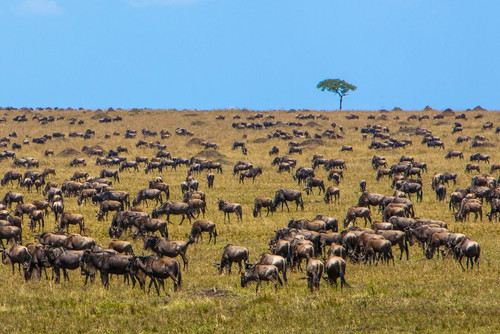Lesser Flamingoes, Lake Natron, Tanzania
See Our Perfect Planet: Volcanoes
 By Dominic Couzens
By Dominic Couzens18th January 2021
Dominic is a Naturetrek tour leader and one of Britain's
best known and most prolific natural history writers.
It might be called A Perfect Planet, but the new BBC series narrated by Sir David Attenborough is, let’s face it, A Perfect Wildlife Documentary. Everything, from sweeping drone shots to close-ups, is excellence itself, held together by the masterly commentary of spritely Sir David. The whole thing goes down as deliciously as salmon for a diving bear.
The first in the series was a curtain-raiser for what is effectively a series of amazing stories loosely connected, in this case by volcanic activity. These ranged from Lesser Flamingoes on the hypersaline volcanic Lake Natron, in Tanzania’s Rift Valley, to the salmon-munching bears in Kamchatka to the astonishing Land Iguanas on Fernandina, one of the Galápagos Islands. The latter climb down a crater 800m deep to lay their eggs in the geothermically-warmed soil. It takes them ten days of climbing to get there.
It turns out that living on a volcanic island can induce some pretty strange behaviour. Take the Vampire Ground-Finch, which lives on two outlying Galápagos islands, Darwin and Wolf. Both islands are very remote, dry and resource-poor, providing scarcely enough food to feed a small bird during the year. So the Vampire Finches, as their name suggests, have taken to feeding from the blood of the numerous seabirds that breed there. They land on the wings of Nazca and Blue-footed Boobies and peck at the base of large flight-feathers to draw blood, which they lap up. Astonishingly, the Boobies don’t seem to object. Mind you, until the late 18th century blood-letting was standard in human medicine.

Nature documentaries don’t shy away from the garish stuff, and there was plenty of drama to be witnessed in the extraordinary story of the Lesser Flamingoes. In a good year of low water levels, 500,000 pairs nest on the salt flats 3 miles out from the shore of Lake Natron. Once hatched, the young gather into creches (and eventually a huge super-creche) and have a long march to join their parents in the freshwater springs near shore. Not everybody survives the long walk, some simply are too weak, and others are picked off by everybody’s favourite horror-bird, the friendless Marabou Stork (“with beaks like a Roman sword”). So easy are the pickings that the Marabous become sated. The Flamingo sequence included some of the most evocative drone shots I have ever seen.
Talking of being sated, the numerous and varied predators in the nearby Serengeti certainly have good times during the annual calving season of the local Wildebeest. The herbivores congregate here in January and February each year, boosted by the lush grassland in the volcanic soil. Over the course of three weeks, up to 500,000 Blue Wildebeest calves are born, which is 24,000 a day. Not surprisingly, the predators, from Lions to Hyaenas, lick their lips at this easy prey, the sheer scale of the herds is incredible.
Every wildlife documentary needs an “aah”-factor to go with the blood and gore, and in this case it was provided by the River Otters in Yellowstone National Park. In the snowy winter most rivers are frozen, but near the famous hot springs and geysers in the park, the rivers still flow. This allowed for great footage of a family doing the usual otter-y things, including sliding along on their tummies. The best comedy moment was the nearby Coyote providing a rare lesson in wildlife ineptitude as it singularly failed to steal fish from its fellow carnivores.

And on the subject of humour, what is more irresistible than the thought of tortoises in a hurry? But it turns out that, on Aldabra Atoll (atolls are the remains of extinct volcanoes and their craters) the local Giant Tortoises spend the morning feeding and then, in the afternoon, they have to “hurry” back into the shade to avoid being cooked in their shells. They have to park bumper-to-bumper in the few places that are out of the sun.
It probably goes without saying that “A Perfect Planet” is a perfect piece of escapism for our times. Now, though, the possibility of escape for us all is coming into view. Perhaps, soon, we will all be travelling and have the chance to witness some of this wildlife for ourselves. We run tours to see most of what is featured above, including the Galápagos (but not Wolf or Darwin island), Tanzania, Yellowstone and Kamchatka.
Ecuador & the Galapagos Islands
Undiscovered Iceland
A 9-day tour of lesser known eastern Iceland focusing on the stunning scenery, breeding birds and other wildlife of this ...



 Loading search...
Loading search...



